MOROCCO: THE LAND OF THE SETTING SUN
Practical information on Morocco
The best times to visit MOROCCO
MOROCCO is more than just a Culture
The main artistic events in Morocco
Architecture, between antiquity and modernity
Portuguese architecture in Morocco
Music, to the rhythm of Morocco
Moroccan gastronomy: something to spoil your taste buds
Specialties according to the regions of the Kingdom
In the Heart of Morocco: Express Guide
MOROCCO TRAVEL GUIDE: THE LAND OF THE SETTING SUN
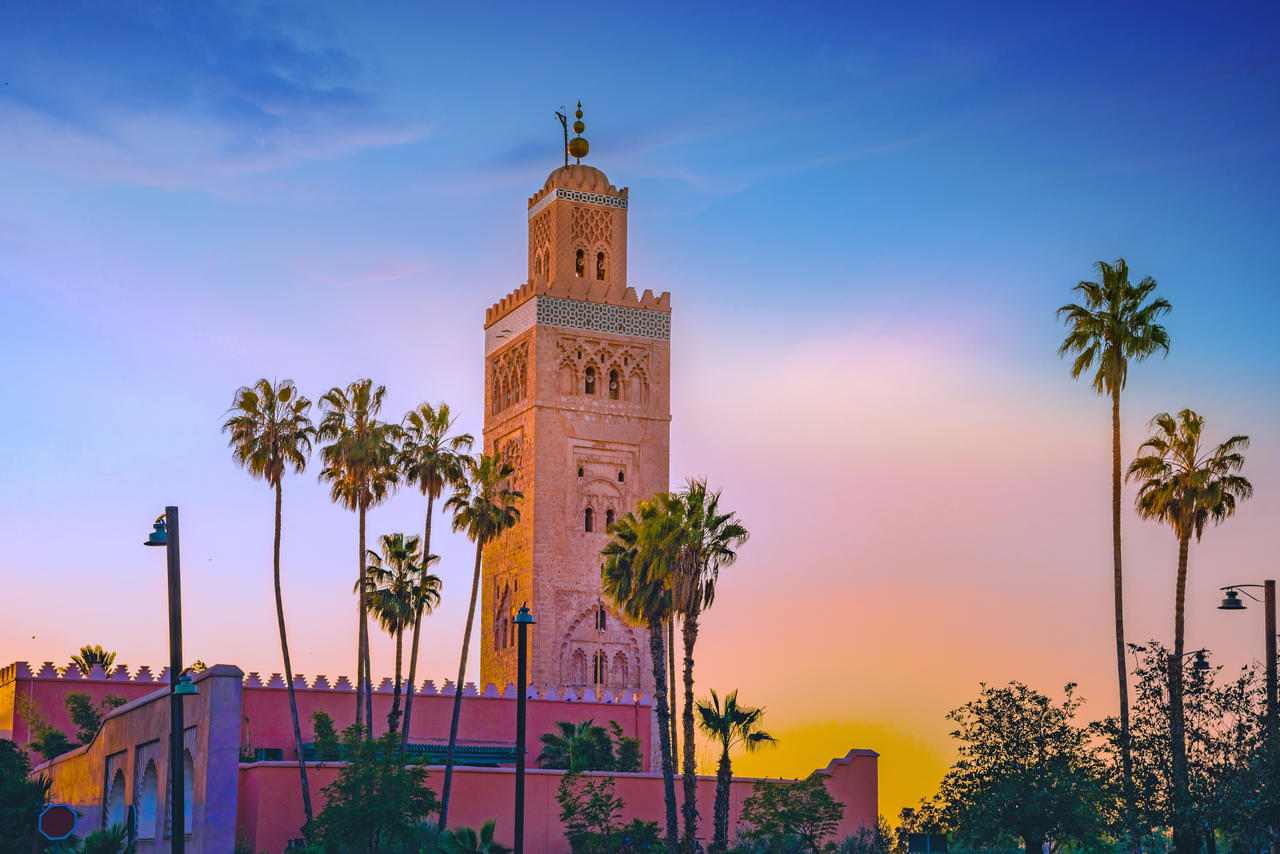
Morocco is more than simply sun, surf, and deserts.
This Atlantic coast country will satisfy all tastes: a rich history from a diversified culture, stunning architecture, imperial cities, amazing mountain ranges, gorgeous dunes, and intriguing food.
The Taste of Adventure will transport nature enthusiasts to the Atlas Mountains, water sports fans to the beaches of Essaouira and Dakhla, and history buffs to the walls of the historic medinas and Kasbahs.
Are you among them? Yes! Then Morocco is your next stop.
We give you this brief Quick Guide to help you plan your next trip.
Identity card:

Almost 36.4 million inhabitants according to the population clock of the High Commission for Planning of Morocco.

Approximately 710,850 km2

Rabat

Classical Arabic (darija), Berber, French (administrations/ media/ education), Spanish (dominant in the Northern region)

Dirhams(MAD)
Practical information on Morocco
Formalities
Is a visa necessary for entry into Morocco? What are the qualifications for acquiring a passport? Here is some information to help you with your journey.
- Passport & Visa
Check that your passport is valid and covers at least the period of stay in Morocco to avoid any inconvenience during your arrival/return.
The requirement for a Visa is determined according to your nationality.
- Cars
Ensure that your passport is valid and covers at least the duration of your stay in Morocco to avoid any problems at arrival or departure.
Your nationality determines whether or not you need a Visa.
The best times to visit MOROCCO
It is great for synchronizing seasons with regions and vice versa. Fez, Meknes, and Marrakech are suggested destinations in the spring and fall. Anyone planning a trip to the Desert should do so between October and February. Summer, on the other hand, may be quite hot in some places, such as Marrakech.
The Atlas region’s winters are famously severe, and temperatures stay chilly all year. The nights are fairly cold due to the high altitude. The coastal districts are accessible all year, with warm winters and temperatures averaging approximately 20°C in the summer.
Despite the frigid temperatures during the off-season, the High Atlas Mountains remain available to travelers all year. Long-distance hikes are not recommended in the summer owing to the heat. The best time to go hiking is between April and October when the weather is nicer. Outside of these months, there is snow on the summits, making the trip more difficult and the views more stunning.
It is important to note that the Islamic holiday of Ramadan may have an impact on Moroccan transportation arrangements. The dates of this holiday change each year, so double-check before organizing your trip.
Dominant languages in Morocco
Morocco has a distinct linguistic landscape.
First, there is Arabic, the language of the Qur’an, which was brought from the East by Islamic conquerors. As in many Arab nations, classical Arabic, which is the language of education/media/administration, is distinct from dialectal Arabic, which differs according to geography and socioeconomic status. Hassaniya is another dialect spoken in the South Saharan areas (Goulmime, Tan-Tan).
Berber is also spoken in numerous locations in Morocco. Arabic, like French, is a foreign language for Berbers. Berber is the oldest known language in North Africa, spoken mostly in the High and Anti-Atlas, as well as in Morocco’s northeast.
The French infiltrated Moroccans’ everyday conversations, a language they had acquired from French rule. The French language is still widely used in Morocco, particularly in the governmental and educational sectors: in fact, practically every Moroccan school/university curriculum includes French as the first foreign language. Don’t be shocked if you hear Moroccans speaking French! Just like the Spanish language, which is another colonial relic. The language is mostly spoken in the Northern Area.
English is now the second most often taught foreign language in Moroccan schools and institutes.
The currency of Morocco
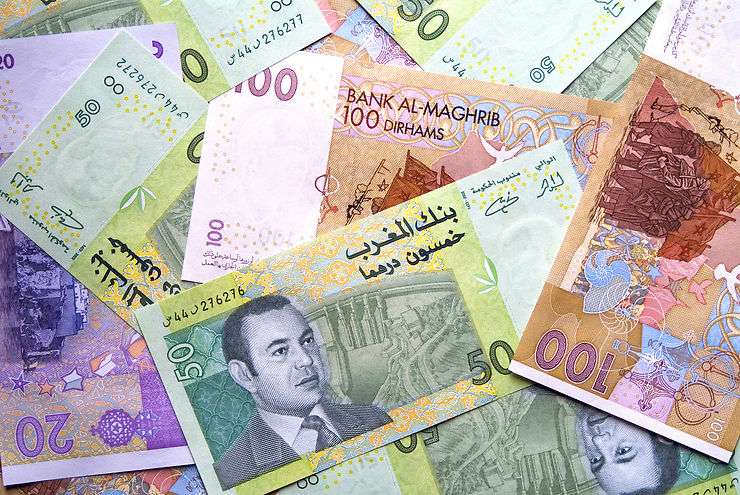
The official currency of Morocco is “The Moroccan Dirham” abbreviated as MAD internationally. The Dirham is not a fully convertible currency, which limits the possibility of foreign exchange outside Morocco.
Before coming to Morocco, knowing how to communicate in terms of money is essential.
At the Souk (Market bringing together shops and workshops) for example, small sums are given in rials (1dirhams = 20 rials).
If you are told 400 rials for the price of a commodity, do not panic, it is only 20 dirhams.
The Change
Exchange offices can be found almost everywhere, whether they are affiliated with a bank or not. Banks are also changing, but their hours are more restricted. Each organization is free to choose its rate. However, it varies a bit from place to place.
In 2021, the Moroccan Dirham is worth about 0.09 euros and 0.11 in US dollars.
It is better to opt for the exchange transaction in Morocco than the withdrawal of cash or the purchase by credit card. Currency exchange remains the best solution with less load.
The budget
The cost of travel to Morocco is lower compared to travel to Europe, America, or elsewhere. We can predict if we are satisfied with the bare minimum, a budget of about 650 Dirhams (65 euros) per day for 2 people: 250/300 Dirhams for a hotel room or maybe less in a hostel. 4 meals per day are worth (60 DHS (6 euros) each and) 240dhs. The rest is devoted to transport, coffee, or visits to historical monuments.
Shopping
The majority of visitors to this country come for shopping. The latter choose Morocco for the high quality of its artisanal products (hand-sewn carpets, ceramics, leather goods, textiles).
Warning: Beware of imitated items from well-known brands sold in souks and opt for souvenirs of the country.
In addition, haggling is a “must” when it comes to buying souvenirs, the best way to negotiate is to first determine how much you want to spend. To do this, check the price of items that interest you in fixed-price stores or any other source of information.
Only start a conversation in a store or market if you are interested.
In any case, the sale takes a lot of time, but it must also be pleasant and a kind of reciprocal exchange between the two parties.
Climate and Weather
The marked contrast between day and night, as well as between winter and summer, is one of the characteristics of the Moroccan climate.
Morocco has a Mediterranean climate with maritime characteristics to the west (temperatures vary from 10 to 26 degrees °C), continental to the middle and east, and dry or desert to the south (temperatures vary from 0 to 40 degrees °C). Morocco has two seasons, one dry and hot (May to September) and the other cooler and wetter (October to April). Hiking in Morocco can be done at any time of the year. Summer takes place in the mountains and along the coasts. The Dades Valley, the Middle Atlas, and the Sarho and Siroua massifs, for example, are best visited in spring and autumn. The arid South, on the other hand, is best visited in winter.
Each season in Morocco offers these advantages and a charm of its own. It is therefore possible to travel throughout the year by establishing your itinerary according to the date of the holidays.
If you want to visit Morocco in spring and autumn, opt for the imperial cities (Fez, Meknes, Marrakech).
For the Sahara regions, the best period is between October and March; the temperature rises to 45 ° C in summer as well as dry and burning winds.
Transportation
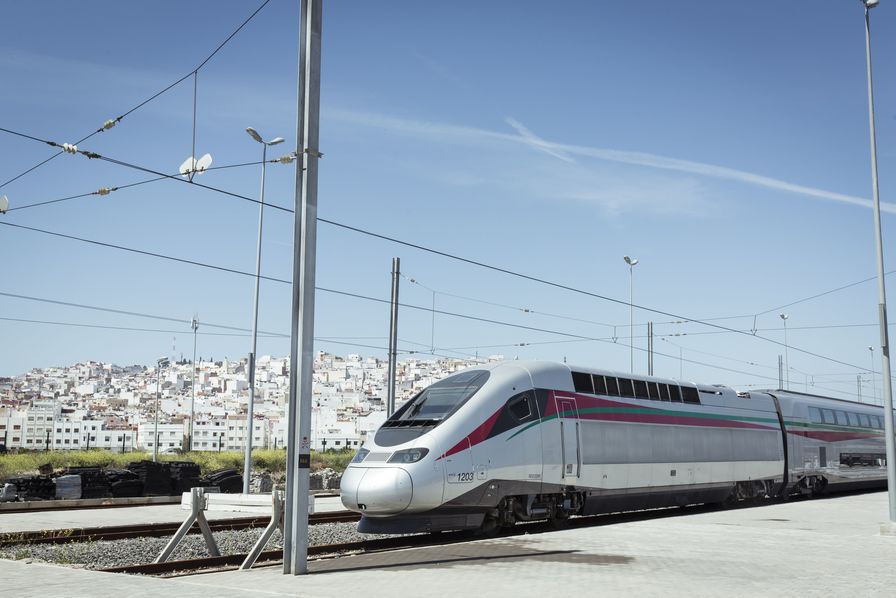
Morocco has had a dramatic development in its transportation infrastructure in recent years, thanks to the construction of roads, railroads, aviation, and sea travel.
Choose public transportation over driving (taxis, coach,). It is regarded as the initial way of contributing to people’s normal-cost travel.
Then there’s rail transportation; he claims Morocco was the first African country to develop a high-speed train. High-speed trains have been a part of our everyday lives for so long that they have become routine. But not for Moroccans, as the country’s first high-speed train line just arrived a few years ago, in 2018. Traveling from Tangier to Casablanca currently takes roughly 1h 30m, compared to more than 5 hours by conventional train.
Although Morocco’s high-speed rail network now mainly serves large cities such as Casablanca, Rabat, Marrakech, and Tangier, it used to make traveling throughout the nation easier. In addition to quick travel times, these trains servicing the new route have a longer departure time and a far greater level of comfort than regular trains. Not only that but Morocco’s high-speed rail network will soon be expanded across the nation, allowing passengers to travel to even the most distant corners of the country while reaping the benefits of train travel onboard a modern train. Appointment at the official website of the National Office of Railways of Morocco: www.oncf.ma which gives you access to all rates and schedules. You can also buy your tickets online safely.
Hotels and Accommodation
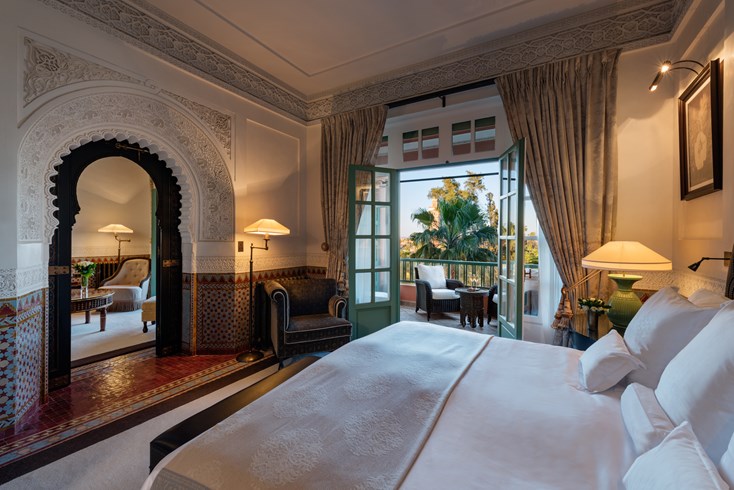
When you arrive in Morocco, you will be faced with a variety of options for accommodation with different budgets from 50 DH and above, ranging from camping in the middle of nowhere to a stay in a starred Moroccan luxury hotel. Everything you will need for a visit to the land of the sun is here: hospitality, well-being, and traditions!
Hotels, Riad & Guest Houses are for people looking for comfort and luxury!
Hotels in Morocco as well as luxury springs including global chains have experienced a remarkable boom in recent years in the major cities of the Kingdom. In 2018, the hotel “Le Mamounia Marrakech” was named the best hotel in the world and Africa according to a ranking made by the British magazine “Conde Nast Traveler”. “The Royal Mansour Marrakech” in turn arrived, by the same magazine, at the top of the ranking of the best hotels in Africa.
Hotel prices vary according to the budget of each and according to the classification in categories in terms of standards of comfort, quality, and management.
Other than the luxury hotels to spend your holidays are the Riad. A unique experience purely traditional in a magical establishment nestled in the old medinas of Morocco.
The Riads originated in Marrakech in the first place, and they are extended to other imperial cities including those of the South. These historic houses offer visitors an atmosphere rich in details building unforgettable memories of the land of the sun.
Open your eyes to every detail of the Riad whether it is the decoration, the furniture, the walls, or the doors … You will see this touch that blows to the rhythm reminiscent of the local typicity of an authentic Morocco.
Guest houses: During the holiday period, the hotel capacity is insufficient, and the locals offer to rent you a room or an apartment. You can visit these places and negotiate with the owners before concluding.
Renting a room with a local is an indispensable opportunity to experience Moroccan hospitality up close.
During a trip in groups, opt for the option of renting an apartment, as it is more economical.
Hostels, campsites, cottages, and bivouacs are the best option to discover and reconnect with nature.
Hostels & gites: Choosing to nest in a gite or hostel allows you to learn more about Moroccan culture while interacting with the locals. The hostels in the heart of nature in Morocco’s main cities are as opulent as they are welcoming, making them excellent forms of accommodation to get to know people better. These comfortable and elegant homes welcome you with a warm Moroccan welcome.
Campsites are the most economical type of accommodation. Stay in a campsite with shared bathrooms, grocery stores, and sports fields … Whether you own a tent or not, you will be welcomed.
Want to discover Morocco in these different facets, all aboard a motorhome? If you want to dig into this adventure, safely, you must, in the first place, make sure to make an online reservation on a website WEB dedicated to renting C-Cs in advance to ensure that vehicles are available when you arrive. The concept is simple: you choose the vehicle you want based on the published price, the type of motorhome/van/van, and the amenities of the vehicle, and you send a rental request to the owner. And finally, confirm your request by receiving a confirmation email to follow up on your payment and then pick up the vehicle on-site.
Bivouacs: Spending the night under the stars is recommended during certain periods to identify all the beauty of the dunes and the charm of a nomadic stay.
Guides and Fake Guides
What to do when you are passing through and you do not know the city, let alone the medina? Should we venture there alone?
A certified guide is often provided with an official guide card from the Moroccan Ministry of Tourism. It can be found at the tourist office, the reception of hotels / Riad. His salary is determined according to a scale. He knows the history of the city as he knows its name so count on him for the smallest detail.
Most official guides love their job and know how to share the love of their city.
Research the city in advance of something that will help you in terms of itinerary.
When it comes to purchases, impose your opinion on what you want and what you don’t want.
Beware of those who are only looking to drag you, for form, from one alley to another without any enthusiasm.
Fake guides: are usually young students from the city who communicate languages well. The advantage of the False Guides is that it lets you, easily, choose your course. If there is one piece of advice to give, it is: Given the number of guides at the entrance of the medina and who may spoil the pleasure of the visit, try to be decided on the choice of guide in advance, it will save you energy and time. (Which you will need during your walk)
Health
Morocco is known for its healthy climate, so no risk in particular.
Other than universal vaccinations (hepatitis, polio, tetanus, pertussis, diphtheria, rabies), the COVID vaccine is in turn at the center of several debates to be able to share this category.
To stay away from any kind of illness or intoxication, we advise you to:
- Wash hands well regularly before each meal.
- Drink mineral or treated water.
- Wash well and peel vegetables and fruits.
- Consume all kinds of well-cooked meats.
- Avoid milk and its unpasteurized derivatives.
- Don’t expose yourself to the sun for a long time.
- In case of acute diarrhea, intestinal pain, or fever; contact a doctor as soon as possible. If urgent: contact the national toll-free number “141”.
Conversely, Morocco has all the necessary characteristics to become a leading medical tourism destination. Doctors have internationally renowned medical expertise and practice very competitive rates of care
Security
Morocco ranked 24th “among the safest countries in the world in 2021,” according to the new edition of Global Finance magazine’s Security Index. At the regional level, Morocco is the safest country in North Africa. This ranking was based mainly on war & peace, the risk of natural disasters, and personal security.
Nevertheless, you have to be careful of scammers and thieves whether in tourist areas or other.
Wherever you are, in Morocco or elsewhere, always be vigilant! It is not easy to trust.
Morocco ranked 24th “among the safest countries in the world in 2021,” according to the new edition of Global Finance magazine’s Security Index. At the regional level, Morocco is the safest country in North Africa. This ranking was based mainly on war & peace, the risk of natural disasters, and personal security.
Nevertheless, you have to be careful of scammers and thieves whether in tourist areas or other.
Wherever you are, in Morocco or elsewhere, always be vigilant! It is not easy to trust.
Internet and WIFI
Today, the Internet in Morocco has become accessible and more developed in recent years.
You can use the Internet during your trip to Morocco either by free WIFI connection that you will find where you go (hotels, restaurants, café) or through a prepaid SIM card for constant access to the Internet.
Holidays and public holidays
The calendar of national holidays:
- January 1: New Year’s Day
- January 11: Morocco’s Independence Day
- May1: Labor Day
- July 30: Throne Day
- August 14: commemoration of the allegiance of the Oued Eddahab
- August 20: Anniversary of the Revolution of the King and the People
- August 21: Birthday of King Mohammed VI
- November 6: Anniversary of the Green March
- 18 November: Independence Day
The calendar of religious holidays:
These above holidays are the main holidays of the Muslim calendar. The dates are changeable every year according to the linear calendar.
- Muslim New Year: the first day of the lunar year.
- Birthday of the Prophet (Eid Al Mawlid): the 12th day of the 3rd month.
- Eid al-Fitr: End of the month of Ramadan. 1st day of the 10th month. During 3 public holidays, Moroccans celebrate it with the family.
- Eid al-Kabir, also known as the Feast of Sacrifice, is celebrated on the 10th day of the 12th month and takes place 70 days after the end of Ramadan. This festival also signals the beginning of the Hajj period, which is the pilgrimage to Mecca. During this celebration, it is customary to commemorate Abraham’s sacrifice by slaughtering a sheep.
Lifestyle and Customs
Morocco, as a Muslim country, has its customs that must be known.
You will be facing a population known for its respect for its customs.
Here are some rules to keep in mind in the interest of being polite to the country that welcomes you.
Politeness: If you enter a place in Morocco, do not forget to greet with polite formulas such as “Salam Alaikum” which means Hello, “Bismi Allah” (in the name of God) who says before eating To thank we say “choukran” (thank you).
Other recommended rules (to do):
- If you find shoes at the entrance of a room, take off your shoes before accessing it!
- Accept the invitation for a glass of tea (even if you’re not thirsty)
- During the Ramadan period, avoid eating/drinking or smoking out of respect for the fasting population.
- Keep silent, out of respect, if you ever pass by a mosque during the time of prayer.
- To make purchases in Morocco, remember that negotiation is “a must” because it is part of the peculiarities of the country. Negotiation is a national tradition that cannot be avoided, even if it can be exhausting.
MOROCCO is more than just a Culture
Moroccan culture comes down to its decades-long history and identity.
This culture is alive and well, manifested by small daily gestures, festivals, rituals, and even simple habits. Spend time there, soaking up the fun and the art of living.
Moroccan craftsmanship
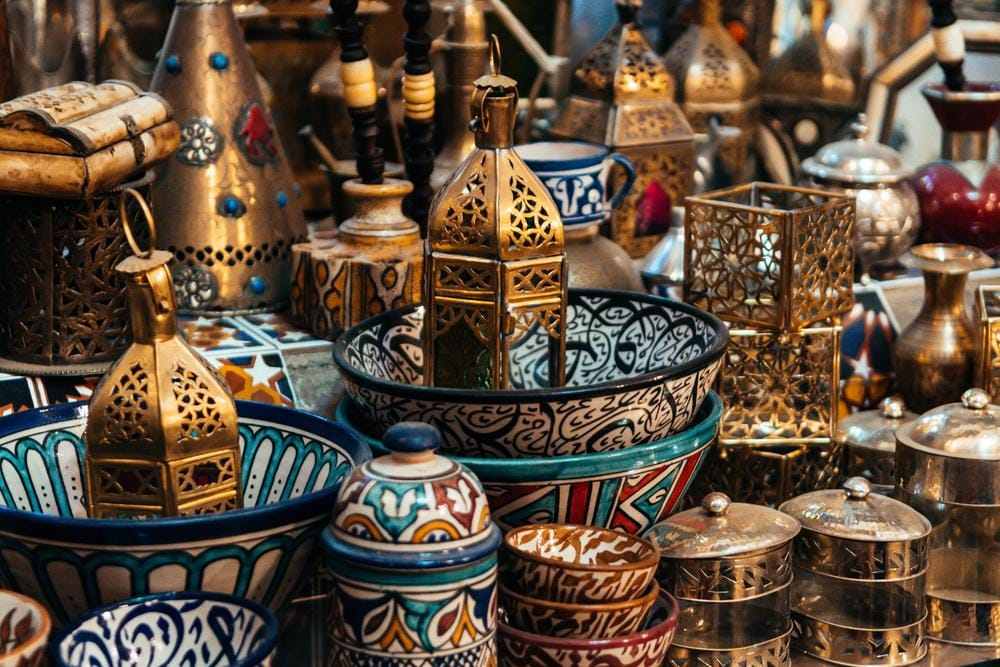
Among all the traditional products of Morocco, craftsmanship occupies a central place.
Morocco is a country rich in craftsmanship and thousand-year-old know-how. Moroccan manufacturing enjoys a well-deserved international reputation, the inspirations, inventions, originality, and brilliance of all the actors of this vast and diverse art never go unnoticed.
The Berbers were the precursors in this field of craftsmanship, as they were the first known inhabitants of Morocco. This was the case in the production of wool, iron, silver, and clay for pottery. With the introduction of the Arabs, various craft forms, such as copper work and wood carving, appeared after the time of Islamization. Pottery, weaving, copperware, ironwork, leather goods, and jewelry are just a few examples.
Wool carpets
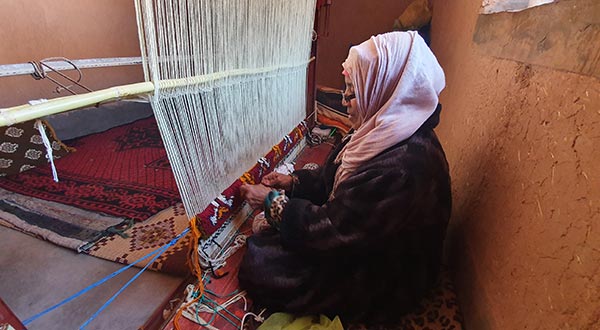
Wool carpets are made by Berber tribes who are native to the Moroccan Atlas Mountains. Manufacturing goes through a special process that begins with the choice of sheep and shearing them. These wool washes and erodes to remove all residue. Then we move on to spinning by hand to make threads purely composed of wool and weave them. The carpets are then connected to create a kind of density before painting the geometric patterns. Before starting the distribution to customers, the craftsmen cut the carpets according to the requested sizes.
To make a carpet, you must be qualified besides the knowledge is passed from mother to daughter, which is why most of these carpets are made by women. The patterns have a long history and have usually reflected the life of the weaver. Some designs can also bring luck or protect against misfortune…
According to myths, it is said that when you have a Berber carpet, you bring the soul of Morocco into your home.
Brassware
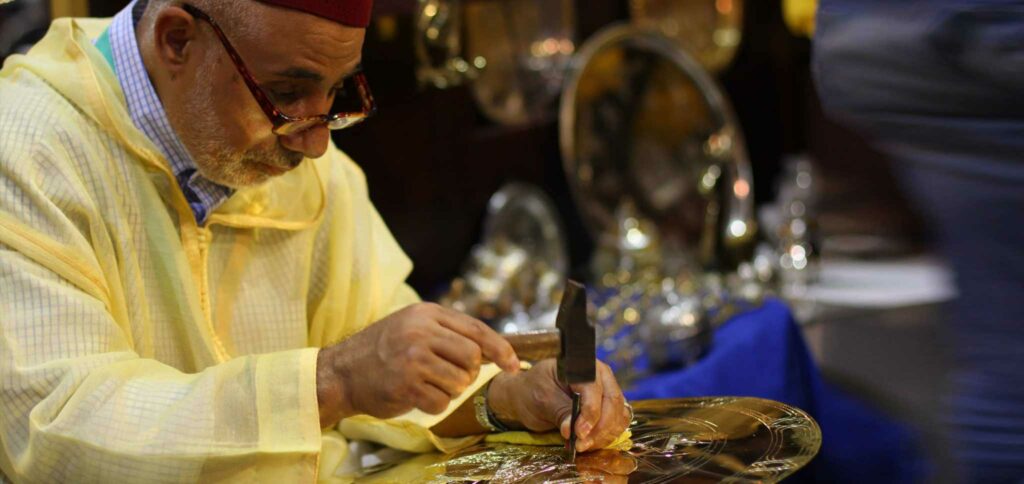
In the 14th century, the art of brassware became a real one. It refers to the artistic work of silver, copper, brass, aluminum, and lead made using various tools, mainly hammers. The brassworking creates practical and beautiful things such as trays and mirrors by hand, using conventional tools. Each piece is one of a kind, precious, and features patterns that are constantly changing.
Many steps are required to complete the creation of a room. Starting with a sheet of metal, the craftsman will hammer it with his mallet. The room will be heated regularly to reduce deformations caused by the mallet. The process is repeated until the required form has been reached. The drawing is then produced using a chisel apart from a layer or directly on the component, which is then welded with tin or silver. Patina is the final phase. Some servings may take several days to complete.
Leather and Leather Goods
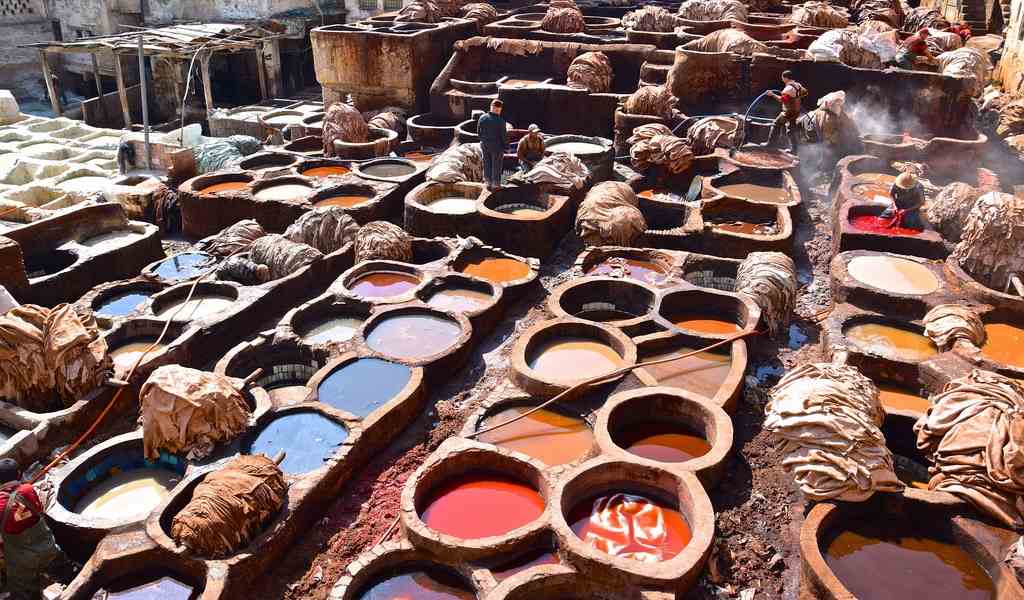
Leather and Leather Goods are one of the most important aspects of Moroccan craftsmanship. The know-how of leather goods was among the first to be recorded in history. Over the years, the Berber people have been known for their meticulous know-how with leather.
Leather goods allow the creation of a wide range of objects, including slippers, belts, clothes, suitcases, ottomans, handbags, etc. Each city is known for some form of manufacturing: in Marrakech, it is embroidered with colored silks or small strips of skin; in Fez, craftsmen are known for the gilding it adds to green and red leather goods; and in Rabat, we specialize in leather repellent. Leather clothing is available at reasonable prices in other Moroccan cities, although the finish and prices leave something to be desired.
Moroccan leather is defined above all by the quality of its texture and its durable luster. This leather is used in all leather goods confectionery, whether it comes from a sheep, a goat, a calf, or a camel. Master craftsmen create magnificent masterpieces such as wallets, clutches, belts, handbags, and travel bags. Finally, the craft of leather goods is transmitted from generation to generation, with variations in style based on time and inspiration.
Marquetry and worked wood
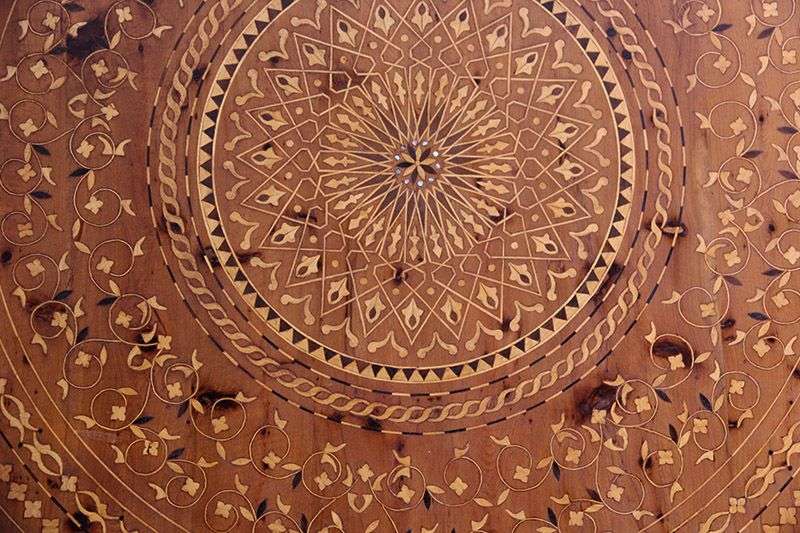
Woodworking has long been a garlic of strength of Moroccan craftsmen. Just look at the magnificent ceilings of the Saadian necropolis in Marrakech or the huge doors of the ancient houses.
In the souks of Marrakech, you can see chessboards under construction and elements for Moucharabiehs being turned, as well as inlays of different types of wooden slats that will turn a tabletop into real needlework.
Cabinetmaking and marquetry are particularly well-known in Essaouira. Thuya root, a warm and fragrant wood, is used. These items also have the advantage of being both inexpensive and of high quality.
Others praise the virtues of cedar, olive, and oak. Wood gives itself to the creativity of artists and cabinetmakers who are motivated by traditional geometric designs, Berber influence, intertwined floral motifs of oriental inspiration, or patterns straight out of their imagination when carved, polished, or painted in vibrant hues. Once the patterns are drawn, the wood is excavated, carved, and punched slowly until it is suitable for varnishing and “zouak” (painting on wood) with its wonderful polychrome games.
Wrought iron
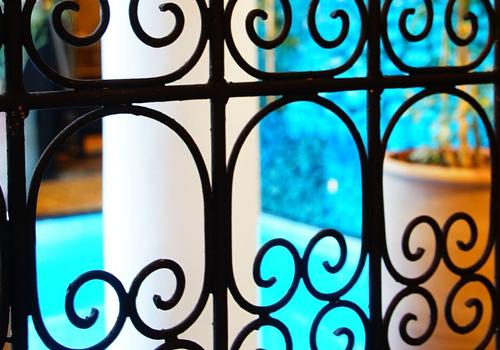
Wrought iron has been used in Morocco since the twentieth century. The purpose of iron manipulation was to mold proven instruments for man to work the soil, or to create weapons (bows, arrowheads…).
The world of blacksmithing eventually turned to the manufacture of more refined and original iron products by maâlams (craftsmen) to build iron objects dedicated to various functions. As a result, we can distinguish craftsmen who specialize in the creation of iron meshes, tables, and chairs or luminaires of different shapes, patterns, and dimensions.
The work of wrought iron has given Moroccan making a unique ornamental touch that is particularly popular with European tourists visiting the country’s main tourist destinations, such as Marrakech, Fez, and Agadir.
In addition, wrought iron in Morocco, especially iron from the city of Salé and traditional iron, is one of the most ancestral professions, which has recently experienced a period of stagnation but will soon rise from the ashes, as it is one of the foundations of international fashion.
Plaster and Zellige
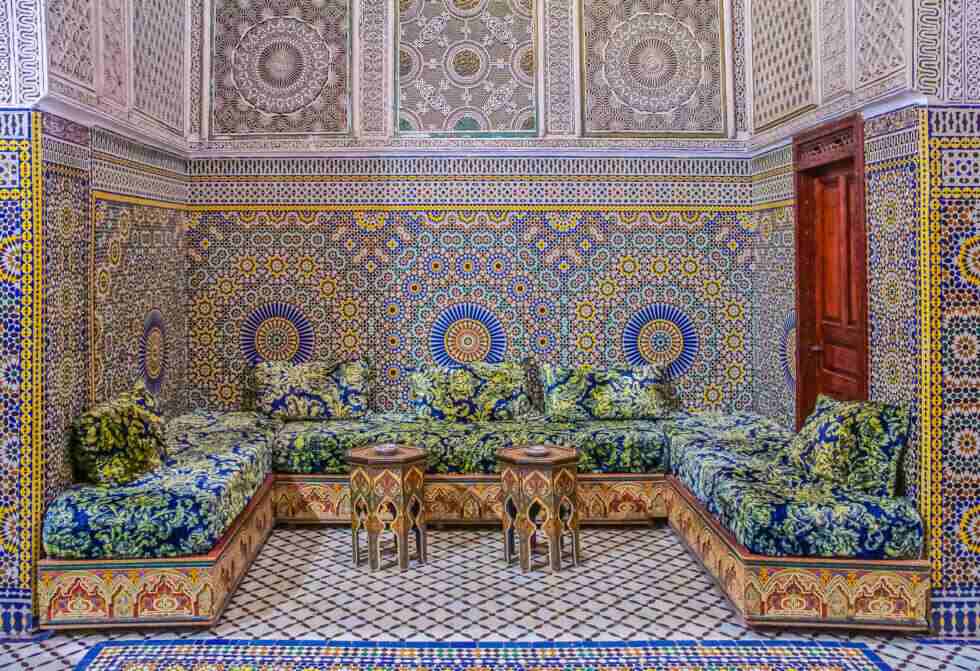
Among the different types of Moroccan décor, carved or painted wood, chiseled plaster, and zelliges, the latter is perhaps the most representative. Their origins are as old as the mosaicists who once crisscrossed the globe. The Zellige method, which was probably inspired by Roman and then Byzantine mosaic, arrived in Andalusia with the Moors more than 10 centuries ago, then crossed the Strait of Gibraltar to arrive in Fez. Zellige evolved in the fourteenth century during the Marinid dynasty, starting with white and brown hues and progressing to blue, green, and yellow. It is only in the seventeenth century that red will be used.
The master craftsmen (the Maâlmins) of Morocco amplify the plaster, sculpt it, chisel it, highlight it, and transform it into a masterpiece. It is usually used to decorate the upper part of the walls, above the zelliges, but it can also be used to decorate arcades or ceilings (mosques, palaces, etc.)
Pottery and ceramics
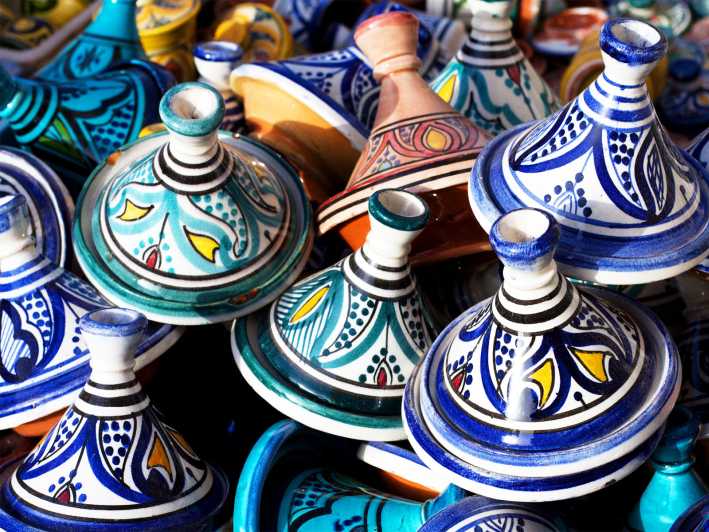
Pottery is a pure Moroccan tradition that has been passed down from generation to generation.
As a result, we can say that pottery in Morocco is a real living art!
Moroccan pottery has a long and varied history, but, over time, it has had to face new ideas to evolve and adapt to new trends, both functional and beautiful, while retaining its authenticity.
Moroccan pottery and ceramics are now regarded as works of art that demonstrate the innovation and ability of Moroccan potters. These two arts are seen as forms of art that showcase Moroccan potters’ originality and ability.
Pottery differs, particularly between the kingdom’s north and south, as well as between rural towns and villages. This variation emphasizes the exquisite Moroccan ceramics, both urban and Berber. The latter, which has a lengthy history, continues to entice with all of the distinctive qualities it can provide.
Pottery is well-known in Fez, Meknes, Marrakech, Safi, Salé, Tetouan, and Azemmour.
N.B.: Among the famous pottery of Morocco, there is the famous Tamegroute pottery, which has kept all its secrets, as well as the pottery of the Rif, which is becoming more and more democratized and has the unique distinction of being an exclusively female pottery, formerly intended for household objects.
Jewelry
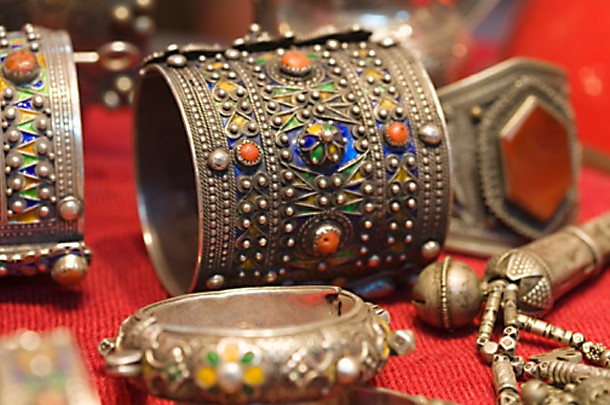
Silver jewelry is one of the specialties of Moroccan craftsmanship. The most exquisite works can be found in the south of Morocco. The most famous town in this region is Tiznit. Jewelry can be modern or traditional, inspired by local or contemporary Amazigh motifs, heavy or light, simple or inlaid with precious stones, decorated with black enamel, or decorated with colorful, geometric, hermetic patterns… in any case, they are always as seductive and varied according to the tastes and preferences of each individual.
For women, jewelry is more than a beautiful thing; it is their only real legacy. It can also serve as a sacred and preventive tool (which protects against diseases: Luban, talismans, etc.) Although it is generally described as being mainly made of silver, it should be noted that women in the urban environment wore only gold jewelry. Amazigh goldsmithing is an art form in which metal is carved into almost magical shapes and vibrant hues. As a result, the Amazigh treasure has stood the test of time in all its grandeur, diversity, and strength.
Traditional clothes
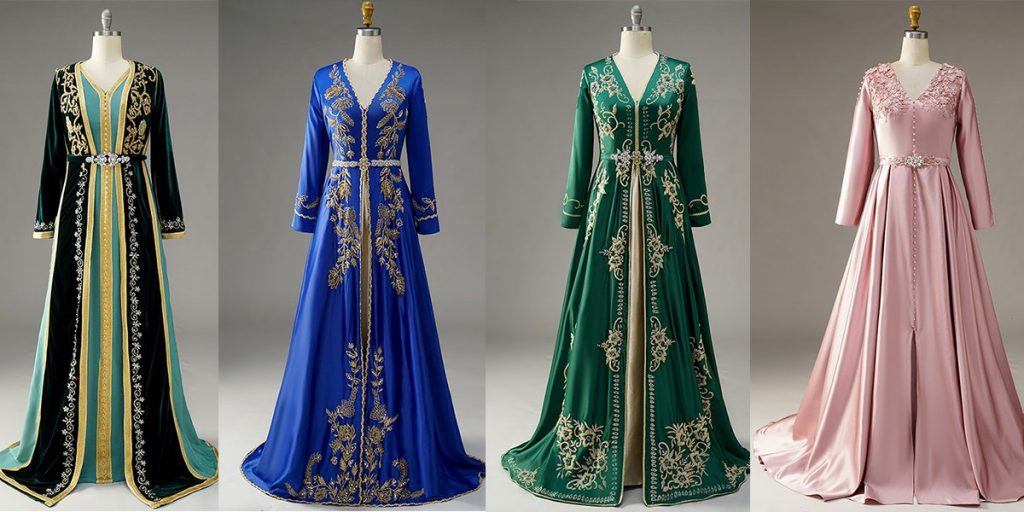
Moroccan clothing is the best example representing the artistic diversity of the Kingdom. These typical clothes differ from one region to another as well as from one cultural belonging to another. But the jellaba remains a junction point between all the latter. The jellaba replaced the Haik (a large fabric that covered women’s faces and bodies before going out) to become the ultimate garment for both men and women. Over time, djellaba developed and became known internationally with much more refined and colorful cuts adopted for both women and men. The men add to the outfit a “tarbouch” which is a kind of small red hat decorated with a black tassel fixed above, they add leather slippers of white or yellow color.
Originally from the time of the Ottoman Empire, the Moroccan caftan is one of the outfits worn par excellence by Moroccan women during celebrations and festivals (religious festivals, weddings, baptisms …). The particularity of the Moroccan caftan lies in its elegance and refinement. Generally worked with noble materials whether silk, brocade, or velvet, it can even be set with precious pearls or embroidered with gold or silver threads.
However other clothes are less known, such as the “Takchita” which is a dress derived from the “caftan”, but which is older; the “Karakou”, a velvet jacket and trousers known in the Eastern region close to the borders with Algeria; the “Keswa el Kebira”, an outfit composed of a breastplate, a corselet, skirts, a velvet skirt embroidered with gold, a belt, a scarf and worn by the “Moriscos” of the regions of Tangier and Tetouan.
The arts, a whole history

Moroccan literature
Moroccan literature is known for its diversity in terms of languages: Arabic,
French, English. It’s hard to know where to start. On this subject, we will suggest 7 proposals of books that will keep you company during your trip:
- Travel to Morocco in the 30s with Driss Chraïbi in “Civilization, my mother… »
- With “The Box of Wonders” by Ahmed Sefrioui you will wander in the alleys of the old medina of Fez.
- “The Sacred Night” by Tahar Benjelloun which won the Goncourt Prize in 1987.
- The 2010 Goncourt Prize was won by “A year among the French”.
- The first novel addressing several taboo subjects in North African society at the time was “Le pain nu” by Mohamed Choukri
- “In the land of others” by Leila Slimani: First novel opus of a trilogy told on the history of Morocco on the march for independence.
“Once Upon a time there was an old happy couple” novel by Mohammed Khair-Eddine precisely describes the portrait of an old Berber couple, happy, living in the high Moroccan mountains.
The main artistic events in Morocco
Every season in Morocco
- A journey through Moroccan poetry
- Visual arts
- Art galleries
- Masterpieces of Moroccan painting
Architecture, between antiquity and modernity
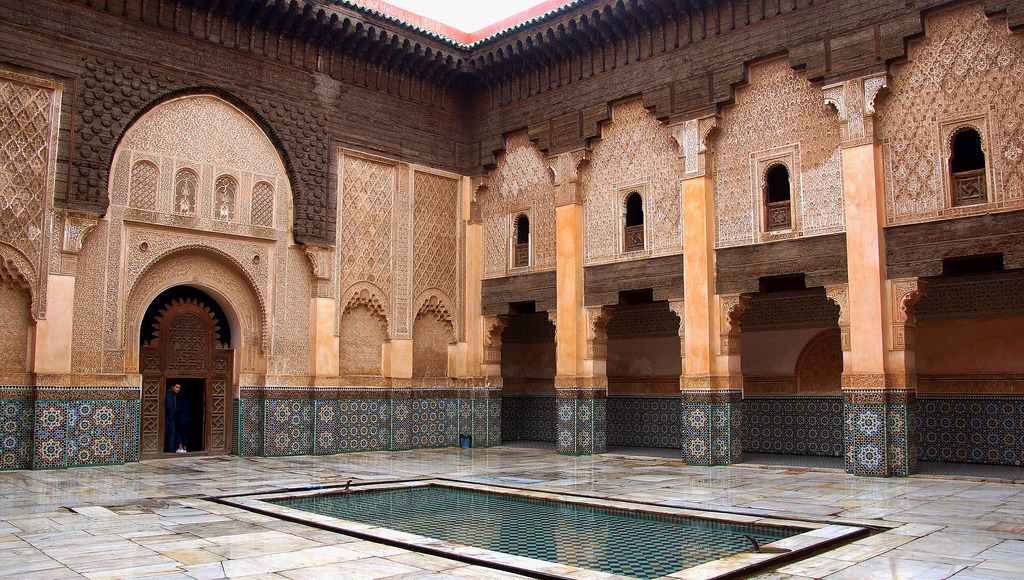
Morocco has been impacted by numerous civilizations over the years owing to its unique geographical location. For ages, the Kingdom has been molded by a combination of African tribes from across the Sahara Desert, Islamic traditions from Arab neighbors, and European invaders. All of these influences have combined to generate a culture unlike any other, which is reflected in the country’s particular architectural style.
Moroccan architecture is notable not only for its extraordinary blend of design elements but also for the unique characteristics of each of its ancient monuments. Mosques, kasbahs, riads, souks, palaces, ramparts, and madrasas are all various types of constructions found across Morocco, each with its purpose and architectural style. We’ll go through a lot of them then.
Ancient Morocco
An antique touch has left its apparent traces through Moroccan architecture.
Ancient architecture can be found in northern Morocco, especially in the ruins of Volubilis (Arabic: walili), which were designated as UNESCO World Heritage Sites (1997).
This archaeological site is marked by triumphal arches, the basilica, and palaces adorned with mosaics all testify to centuries of Roman domination.
The Berber style
Much of the South is in the form of Palaces and Kasbahs adorned with colorful geometric patterns referring to the beauty of the Berber carpet.
These Berber-style structures are built based on natural resources such as raw earth and clay which require maintenance to last over time.
A visit to a Berber village will allow you to learn more about the history of these people, which dates back to the 9th century.
The Arab-Andalusian fusion
We see this fusion through the architecture and grandeur of mosques, large, monumental doors, and palaces. This architecture returns to the time of the 12th century and is known for its evolution through the construction of the Koutoubia Mosque in Marrakech and the Hassan Tower in Rabat.
Portuguese architecture in Morocco
Morocco keeps the imprints of an ancient era of Portuguese cohabitation, especially in the cities of Mazagan today named El Jadida, Asilah, Safi, and Mogador Essaouira. These Moroccan cities are home to some of the best examples of Portuguese architecture in the world, as well as vast stretches of sandy beaches filled with light.
Colonial architecture
Colonial architecture first appeared in the Kingdom of Morocco in the twentieth century, particularly in the cities of Casablanca and Rabat, with a European design originating from the age of the French protectorate, which gave rise to a new urban environment under the push of Marshal Lyautey.
Contemporary style
Morocco’s architecture is expected to take on a new character with the introduction of many major projects such as the Morocco Mall in Casablanca, the headquarters of Maroc Telecom, and the National Library in Rabat, as well as other development projects in the pipeline. This renovation intends to entice visitors to explore “the new face of the Kingdom” and discover its beauty.
Music, to the rhythm of Morocco
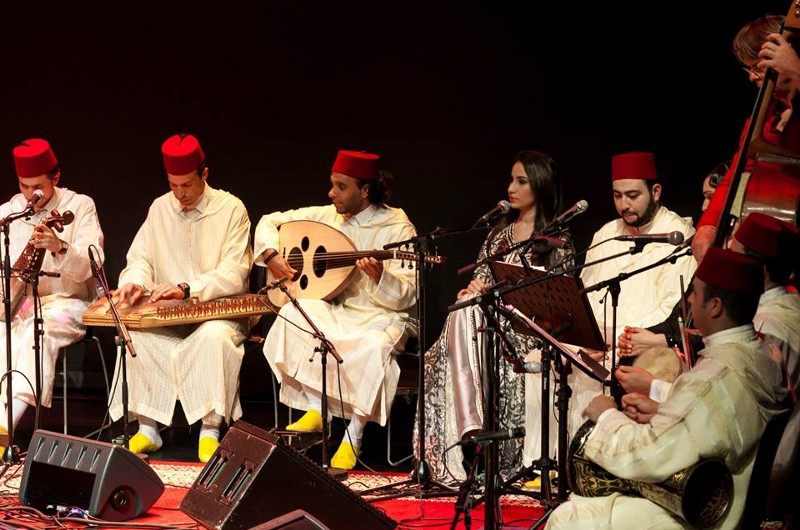
In everyday life, Morocco still offers today the image of a country where music has retained its influence and the musician his privilege. In Morocco, we feel a kind of love for music that seems to come from the depths of the ages.
Discovering Moroccan music is one of the good reasons to visit Morocco.
Popular music
It is a very light kind of music, in dialectal Arabic, that only its purpose is entertainment. You will hear this kind of music at the artisans, the shopkeepers…
There are a few genres of popular music:
- Malhoun: which reserves a large place for poems that describe everyday life (love, politics…). Played by special instruments such as the Oud, the guembri, or even the violin.
- Ayta: meaning “call” is a kind of music from Haouz Marrakech: it is a cry on a high note accompanied by dances performed by women.
- Chaabi: is the very popular music in Morocco. It is the song of festivals and celebrations played with instruments like La Darbouka, Bendir, Oud, and Violin, …
- Rai: born in Algeria and developed in Morocco. Inspired by the Malhoun, becoming among the most popular forms among young people especially. In honor of this music, an international festival of Rai is organized especially in the city of Oujda in Morocco.
- Issawa: its main spiritual center is in Meknes (Zawia) where its founder is buried.
- Classical music
In Arabic (Moussika Classikiya), it is music, poetized in literary Arabic of high quality, which entertains learned men and men of letters.
Berber/rural music
Morocco, being an Arab-Berber country, is endowed with a rich musical tradition. The Berber songs and dances are a performance rich in poetry and color, inspired by the beauty of the rural and Mediterranean environment.
Moroccan music is divided into many styles, with Berber music accounting for 70% of the total.
Moroccan Rap/ Reggae
The origins of hip-hop and urban arts in Morocco date back to Meknes in the mid-80s. Moroccan rappers have gradually changed Western rap to Moroccan rap (a combination of traditional Moroccan music and Western rap), which is usually sung in a mix of Moroccan Arabic, Berber, French, and English.
Meanwhile, reggae is gaining popularity among young people in the country’s major cities, especially Casablanca. Since then, many young people have been seen donning Jamaican-themed clothing or head coverings, as well as wearing the Rasta haircut.
Dances
Impossible to come to Morocco and not attend a collective folk dance.
The Ahouach, known in the High Atlas among the Chlouh tribes, is performed by women while men play bendir.
The African rhythms of the Gnaoua have been preserved. Known in Essaouira, Marrakech, and some small communities around Merzouga. Do not miss the Gnaoua and World Music Festival of Essaouira to attend several demonstrations of dances and animations.
Moroccan gastronomy: something to spoil your taste buds
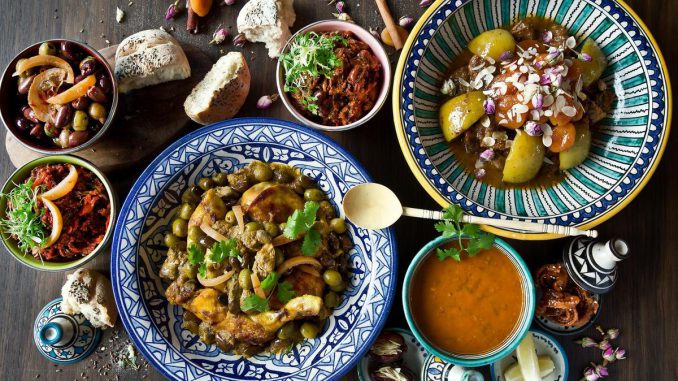
Moroccan gastronomy is considered one of the best cuisines in the world. It was ranked 2nd best gastronomy in the world in 2014 according to WORLDSIM Travel Blog.
Its astonishing range of influences is one of the reasons for its importance. Moroccan cuisine reflects the country’s long history of trimmers and emigrants who have left their mark in colorful ways. Barbecue (kebabs) was introduced into Moroccan cuisine by the Ottoman Empire. Although it was short-lived compared to the reigns of some of these other empires, the French colony left behind a culture of coffee, pastries, and even wines. Cooks from the four royal cities (Fez, Marrakech, Meknes, and Rabat) have designed and refined recipes that combine each of these distinct flavors over time. Each Moroccan meal has a social function and changes depending on the market, season, and region.
Specialties according to the regions of the Kingdom
Casablanca is known for its couscous with seven vegetables, and this is also where the seafood pastilla originated.
The northern Tangier-Tetouan region is known for its traditional Mediterranean cuisine such as pailla, as well as for its extremely ancient Moorish specialties such as Sfiria, tagine mezgeldi, pastilla de Tetouan and, of course, a sophisticated and ancestral pastry.
In the mix atlas, Andalusia and Tafilalt, Fez, the historical capital of Morocco for many centuries, has retained the reputation of a Moroccan cuisine of great occasions and where reception is an art in its own right. As for Meknes, an agricultural region par excellence, the combination of freshness and flavors at the rendezvous. It shares many similarities with Fez and Sefrou.
The terroir of Mechoui and Gibier par excellence, as well as tagines scented with herbs, are found in the Middle Atlas.
Rabat/ Salty: Typical Moorish cuisine: Gambetta, M’killa, Kadra R’batiya, almond paste cake…
El Jadida, Safi, and Essaouira are the main cities of the gastronomy of Western Andalusia (western Spain and Portugal); they are part of the Moroccan-Portuguese heritage, and their cuisine is not to be missed: market salad, fish dishes, and tagines, the famous safiote and souiris cakes: “Massa bane“. Let’s not forget the Berber cuisine and the Jewish cuisine have left their mark on this terroir; Jewish cuisine is also known for its special cakes.
Agriculture
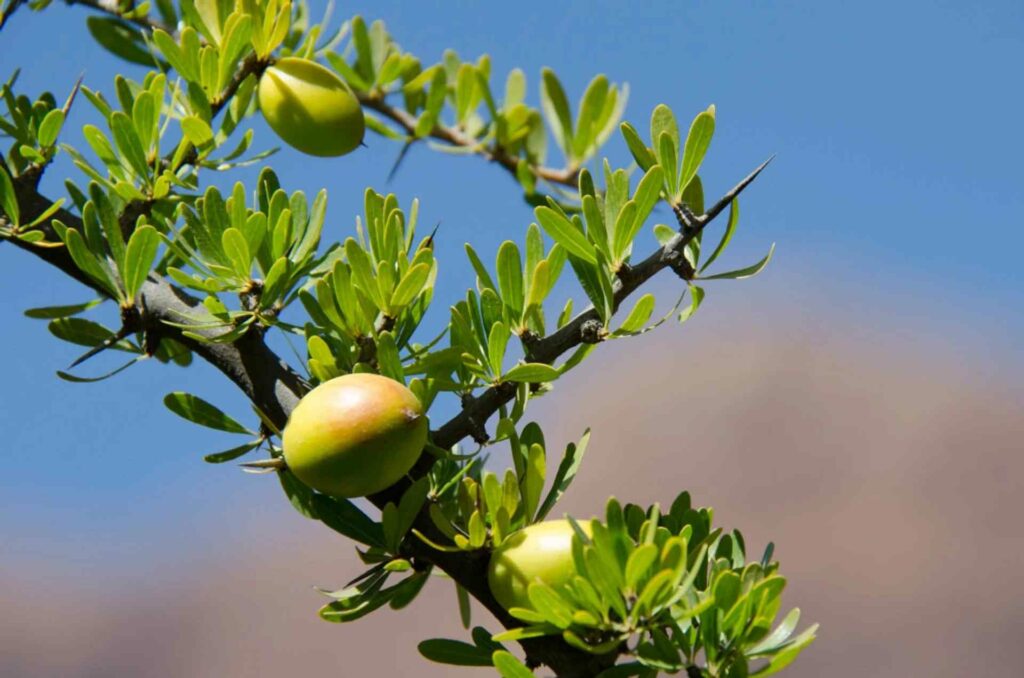
Known for its citrus fruits, cereals, and vegetable oils, Morocco is an agricultural country par excellence. Agriculture plays a key role in the economic and social spheres.
Local national products
With its ancestral know-how and generous nature, Morocco has a panorama of sumptuously rich local products. Each region has its own specialty refined and shaped by skillful craftsmanship and heirs of ancestral know-how.
There is a wide range of local products. For the Hammam ritual, think of Henna, rose-scented clay, and black soap for an incredible experience. For a full breakfast products like goat cheese from the Agadir region, olive oil, and honey.
The products present here are to slip necessarily in your luggage.
Argan: the oil with a thousand virtues
A local vegetable oil with beauty and medicinal benefits derived from the argan tree. It firms and softens the skin, restoring elasticity and suppleness. It is also an antioxidant and anti-aging agent, neutralizing free radicals and combating the effects of skin aging.
Saffron, red gold
Very common in Moroccan cuisine, saffron is a spice, which contains many virtues. An antioxidant, a relaxant, and rich in iron and magnesium, it is also a source of energy and vitamin B6. Grown in the “Taliouine” region, saffron is a very popular spice. It has long been used in traditional medicine and is now finding its place in cosmetic recipes.
Rose water
A rose that grew in the Valley of the Roses between the Dades Valley, Kelaa M’gouna, and Boulmane Dades, a village with captivating scents that is aptly named. The water extracted from the rose is an essential of Moroccan cosmetics. With its soothing and cleansing properties, it will find its place in your toiletry bag or on your coffee table.
Orange blossom water
You have probably tasted the sumptuous aroma of orange blossom while tasting Moroccan pastry. Grown and distilled in the Khamis region, orange blossom water can be used to flavor cakes or during your beauty rituals.
Honey, for any occasion
Known worldwide for its medicinal and cosmetic properties, honey from Morocco is indispensable. In addition to being a sweetness to consume at breakfast or accompaniment to desserts, it is ideal for the beauty of the skin and hair. It’s also a good idea to offer to your friends and colleagues.
The economy, a growing country
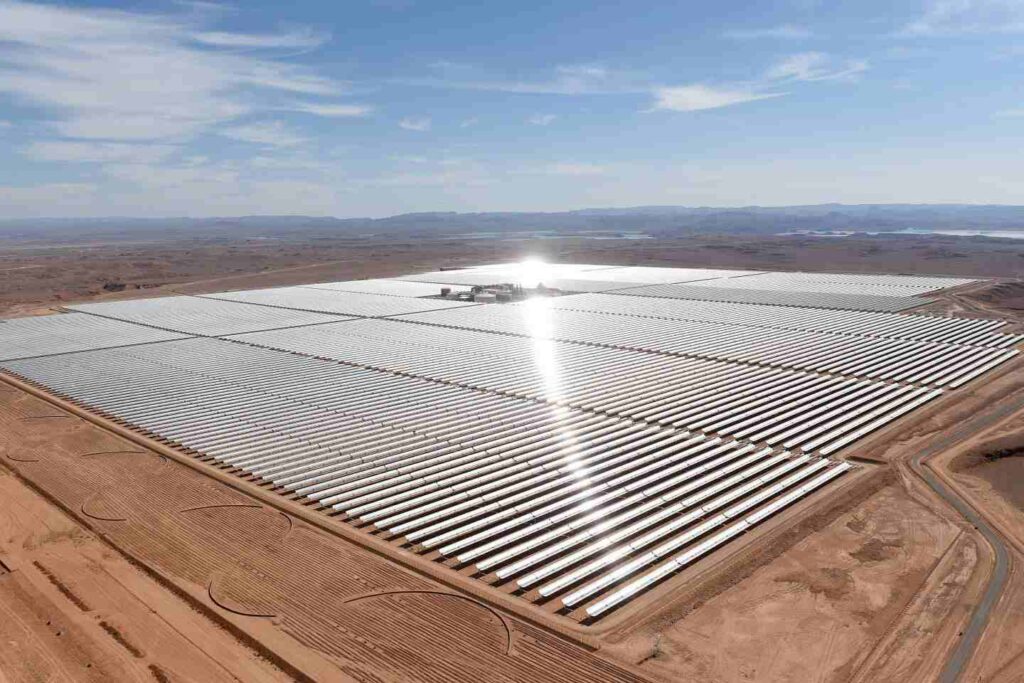
The Moroccan economy
Morocco has chosen political plurality and economic liberalism since its independence, with the right to property and the ability to engage in business as one of the primary rights granted by the Constitution.
Morocco has pursued an external openness strategy aimed at trade liberalization and contributing to the consolidation of the global economic system since the 1980s.
As a result, significant breakthroughs in the modernization of economic, financial, and legal systems have occurred. Morocco strives to sustainably boost economic growth and enhance inhabitants’ living standards.
It is the African leader in Open Data, automotive, and aeronautical manufacture, in addition to being the global top in phosphate mining and production. Morocco is making remarkable progress on the international stage, particularly in Europe. The EU has granted Morocco “Advanced Status,” which allows it to integrate further into the European Single Market and participate in certain inter-European cooperation programs previously reserved only for member countries.
To date, the country’s key reforms and initiatives have yielded fruit, with GDP growth. Aside from agriculture, there is also the service industry. (especially with the telecommunications sector and the development of offshoring).
Agriculture accounts for 20% of GDP and employs 45% of the total working population at the sectoral level. The secondary sector contributes for 30% of the GDP and consists mostly of phosphate mining and processing, textile manufacturing, and agri-food processing. The tertiary industry accounts for 38% of GDP, with tourism accounting for roughly 8%.
The Kingdom's major projects
Ports and maritime links
Morocco contains 38 ports, 13 of which are classified as international trade friendly. Morocco, as part of the National Plan for Industrial Emergence, and with its 3500 km of coastline, is an important point of marine linkages. The United Nations Body on International Trade (UNCTAD) rated Morocco 16th in terms of marine connectivity in 2014, after the United Arab Emirates, Italy, and Spain.
Sustainable development
As part of its National Sustainable Development Strategy, Morocco takes the issue of sustainable development seriously. The host country of the Cop22 in 2017 in Marrakech and a major player in the Earth Summits in Rio de Janeiro (1992) and Johannesburg (2002), it launched our projects:
- Noor Thermodynamic Solar Power Plant in Ouarzazate
- Wind Farms: Tangier and Foum El Ouad
- The green city of Benguerir
- Desalination plants for seawater
Sports and recreation
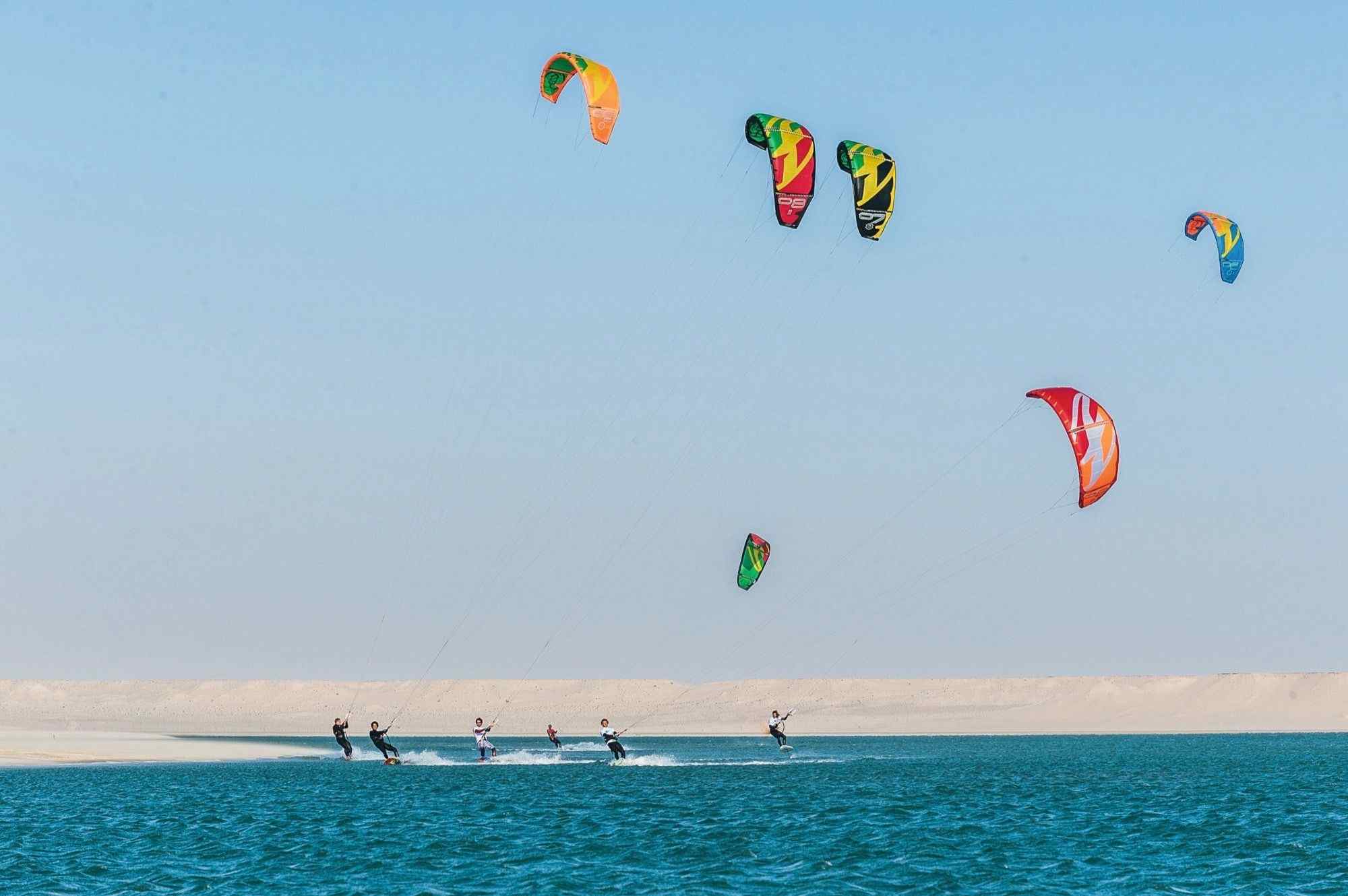
By adding sports and leisure to your trip, you will live the most incredible experience you have ever dreamed of… Starting with horseback riding and camel tours, move on to admire the best sunsets and finish with a candlelit dinner under the bright stars.
It is a country known for its panoply of sports; sports in all its forms: on/underwater, on/underground.
Horse riding
During your stay in Morocco, opt for a small getaway on horseback for a long hike by the beach or forest. You will find this sport in the cities of Marrakech, Meknes, El Jadida, and Oujda…
Surf
Surfing, kitesurfing, or Windsurfing are trending currently. Enthusiasts come from all over the world to discover the impressive waves of Dakhla, Essaouira, or Taghazout (Agadir)
Diving
For scuba diving enthusiasts, head to the beaches of Morocco for impressive landscapes at the bottom of the oceans.
Golf
The golf experience in Morocco varies according to what you want, whether under the sun, on the shores of the Mediterranean, or in cities rich in history and culture. Morocco has beautiful land so famous throughout the world. Golf enthusiasts will be delighted!
Skiing
If you visit Morocco in winter, go skiing at one of the 2 most famous resorts: Oukaïmden near Marrakech (2600m altitude) or Michlifen in Ifran.
The particularity geography of MOROCCO:
Morocco on the map
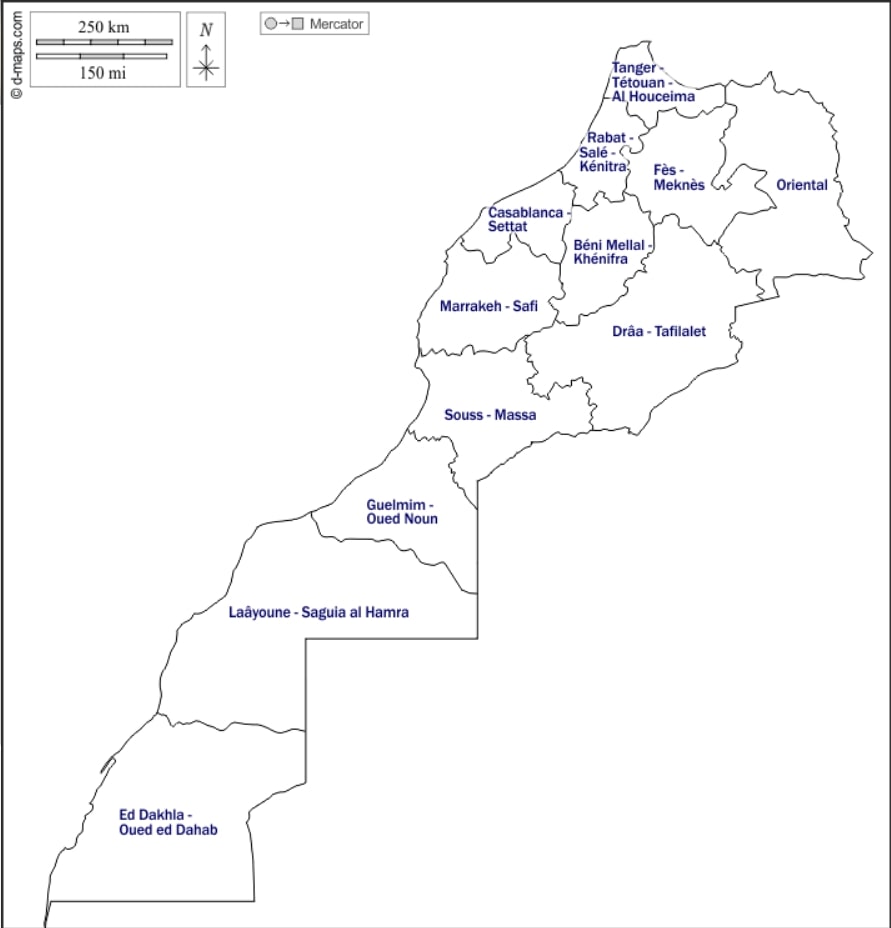
Morocco is a confluence of natural landscapes, located at the crossroads of Europe and Africa, surrounded by the Mediterranean Sea and extending over the immensity of the Atlantic Ocean. It is the “land of the setting sun”, a place full of contrasts with a rich history that arouses interest and inspires exploration.
Morocco is a nation in the North African region. It’s framed to the north by the Strait of Gibraltar and the Mediterranean Sea, to the south by Mauritania, to the east by Algeria, and to the west by the Atlantic Ocean. The Moroccan coastline is about 3500 kilometers long.
- The area of Morocco extends to 710.850 km²
- Its mountain ranges are High Atlas, Middle Atlas, Anti-Atlas, Rif…
- Its rivers: Loukous, Abou Regreg, Oum Rbiâ, Oued Dades, Ziz, Tensift, Souss…
- The maritime facades: the Atlantic Ocean 2934 KM and the Mediterranean Sea.
You will find the ruins of the greatest Mediterranean civilizations in regions where many dynasties have succeeded one another.
Magnificent stunning views are shown between the sea and the mountains, the sandy sand and the lush plains, to meet your need for serenity and natural beauty; captivating colorful paintings with the richness of a war-fighting culture transport you to a surprising nature.
Geography and geomorphology:
Mountains

A mountainous strip stretching all along the Mediterranean and the Atlantic Ocean ends in the Moroccan Saharan South.
The panoramas are varied and breathtaking: the peaks dominated by eternal snow of the High Atlas, the vertiginous steep and ravines of the Rif, the forests decorated with oaks and cedars of the central table, the rich plains of the Meseta, the thirsty lands of the mounds, the semi-desert downs, and the lush oases of the Souss receptacle, and the stacks of the Sahara.
Beaches
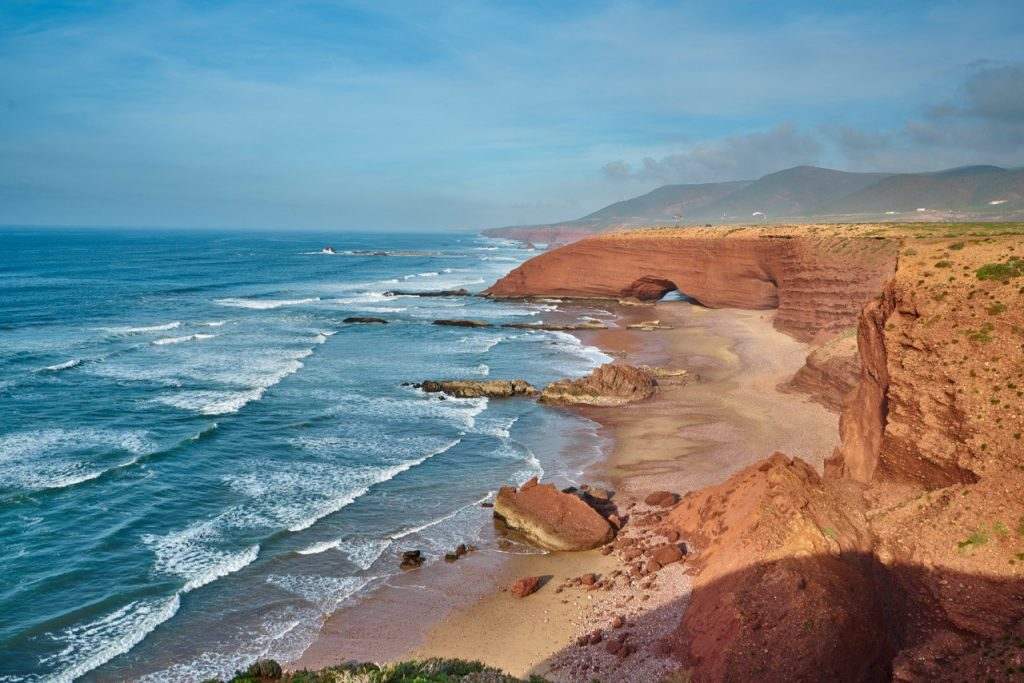
Morocco has 3500 km of beach. The Mediterranean extends for 500 km to the north and the Atlantic to the rest of the country. Paradisiacal beaches, renowned resorts, original cities, secluded bays, and wild beaches attract thousands of tourists every year.
Here is our selection of the best beaches to visit:
- Dragon Island Beach – Dakhla
- Essaouira Beach
- Sid El Bachir Beach – Saïdia
- The beaches of Nador
- Oued Laou Beach and surroundings – Tetouan
- Quemado Beach- El-Hoceima
- Taghazout Beach – Agadir
- Oualidia Beach
- Dalia Beach – Tangier
- Wild beach – El Jebha
Sahara
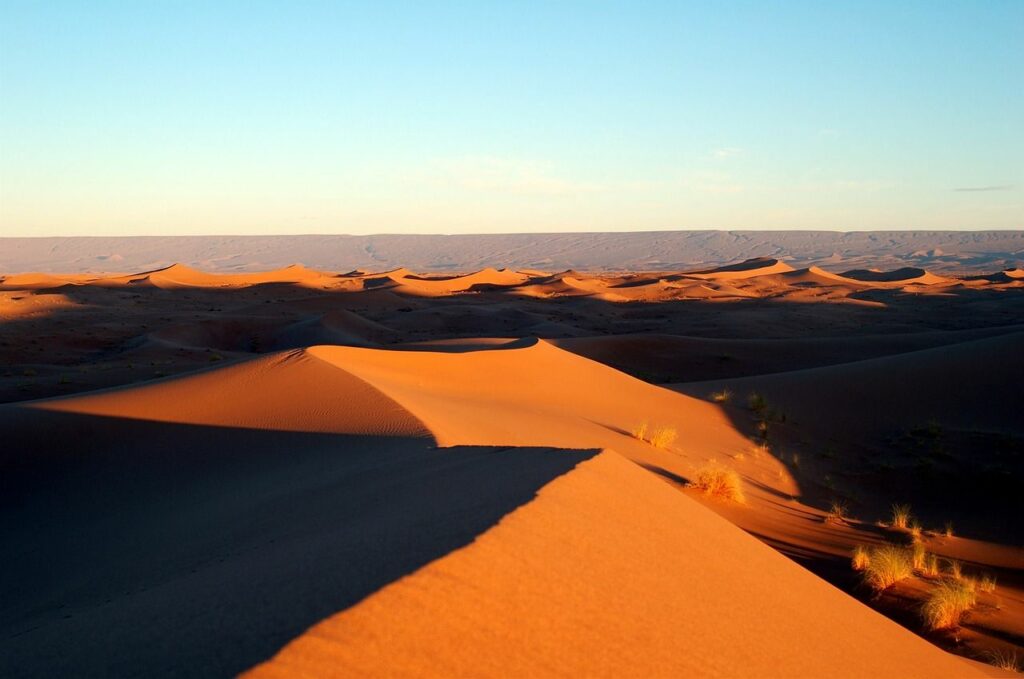
In the south of Morocco, along wadis and palm trees and crossing the regs of stones browned by the sun, is the Sahara. To the rhythms of nomads, cross the desert on camels in a caravan. The dances and songs of the local Saharawis around a fire will then give way to an absurd silence under the stars. Discover the highest dunes with your eyes immersed in the sparkling immensity of the sky of the Sahara of Merzouga. As you go east, the desert becomes more ochre and the landscapes wilder.
Live an incredible experience, unique in the world.
Fauna and flora
Each territory is a flora and fauna that is currently preserved in a philosophy of sustainable tourism development. Gazelles, adults, mouflons, and fennecs are not unusual, and their mode of existence can be easily observed. The sacredness of Morocco… Morocco offers such geographical diversity that one morning, you can meet the beautiful beaches of Agadir at the foot of the ski slopes of Oukaimeden before descending to spend a pleasant night in the palm grove of Marrakech.
